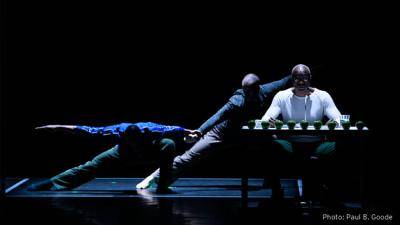Antics Performance, under company Artistic Director Amy Campion, has already ventured beyond the usual realms of street dance with their mini-scaled Nutcracker which was performed as part of the annual Holiday Program at the Music Center. This past weekend at Los Angeles Theater Center they voyaged even further afield in a retelling of the Mesopotamian Epic of Gilgamesh in a two act work drawing on contributions from Los Angeles graffiti artists, designers, composers, film makers, and animators. The evening was produced in conjunction with the Latino Theater Company.
Campion is an effective and thoughtful storyteller.
Titled Illuminated Manuscript, the evening length work in two acts fared best when leaning on its original sound score (music by Campion and others), flashy graphic displays, projections, animations, and its stylish crew of thirteen dancers including Bboys, lockers, capoeiristas, and hip hoppers. It felt less in tune with its literary and historical themes when weak acting didn't always cover transitional moments, or when too much story seemed to overwhelm the skeletal gloss of the epic itself. Gilgamesh preceded illumination. Campion's work here is not a reference to manuscript illumination in the standard sense of the word (the narrative originally was impressed onto clay tablets), but a way of looking at the Gilgamesh story colorized through street dance and its related cultural offshoots such as house music and the ubiquitous have- spray-can-will-travel muralists of the rail yard and beyond. The only characterizations that went astray came in the second act when Gilgamesh’s quest for immortality offered confusing metaphors. In his search for a wise man, Campion offered Gilgamesh a soothsayer who seemed more prototypically Chinese (a Shaolin type perhaps) than a figure born out of the mud, stone and reeds of Mesopotamia. Even the music veered confusingly eastward.

Campion is an effective and thoughtful storyteller. Act I of Illuminated Manuscript moves with more precision and coherence than Act II. The cast introductions are clear and important plot points are dependably reenacted. Act II didn't feel as sure of itself, though it did have a forceful opening with Marco “Peru” Serna breaking with real power and athleticism as the Bull of Heaven. Another aspect of the storytelling that seemed true was the relationship forged between Gilgamesh (Gilyon “Gillatine” Brace-Wessel) and Enkidu (Samuel “Panda” Nakama). The two, who first come into conflict and battle for respect in a traditional circle, forged a convincing onstage chemistry. When Enkidu dies the pain is real. The movement, an extended funereal procession, was solemnly borne by a Bach Sarabande (B minor Partita) for violin alone. It was the only episode of the story that didn't rely on a hip hop track. It felt justifiably isolated as an expression of grief.
Also exceptional was Marie “Pandora” Medina, whose monster popping and locking solo as the character Ereshkigal in Act II set a high water mark for musicality and menace.
Campion has flooded her tale with compelling graphics, music and film. One section of animation (Sapphire Sandalo) references a version of the Noah's Ark story which is buried in the Gilgamesh narrative. Clips of a film showing the creation of a mural punctuate the onstage story and made provocative comments for both the muralists and the film maker as parallel storytellers. But the lion's share of continuity goes rightly to Campion and her musical collaborators, Amida Shofu, J-Alphumus, and Asa Watkins for a score that never let up and which dependably offered the dancers solid instrumental tracks to back the choreography. Also exceptional was Marie “Pandora” Medina, whose monster popping and locking solo as the character Ereshkigal in Act II set a high water mark for musicality and menace.
As I watched Illuminated Manuscript I wondered if this was a tale best rendered and felt through the hip hop genre. Aren't these characters beyond the ken of the hip hop world. What do any of us really know about Sumeria and its ancient heroes. And where is that home grown, urban tale where characters such as Enkidu, Humbaba, and Shamash are replaced by an equally compelling tale and cast with monikers such as “ Tha Beatdown”, “Kid Enzo”, and “Gyroe”? Chances are an Eastside story, for Angelenos, by Angelenos, is just around the corner.
In addition to those mentioned above, the cast included: Amy “Catfox” Campion, Alfonso “Kid Enzo” Colichon, Liliana Frias, Christina “Girl Shofu” Jimenez, John “Random1” Molina, Kina “Wonda Woman” Prado, Amida “Shofu Tha Beatdown” Shofu, Aaron “Stylez” Thompson, and Garvin “Gyroe” Tran. The graffiti mural film was by Avi Cohen with muralists “Gallatine” and “Panda”. Design and technical direction were by Tyna Kennedy, Crystal Star, and Mark Cabalquinto. The choreography was by Campion in collaboration with the Antics Performance dancers.



